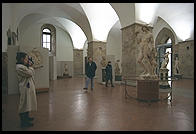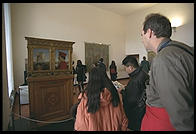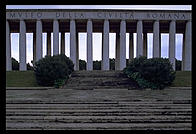
The best pictures tend to be had during two hours around sunrise and two hours
around sunset. You might be able to get a "guidebook-type" photo when the sun is
high but you certainly won't capture any atmosphere or romance.

Film is 50% more expensive in Italy than in the better NY mail order houses. I recommend Fuji 400 negative film for street life and people, Fuji Velvia (ISO 50 slide film) or Kodak Royal Gold 25 for landscapes. Fuji Sensia (ISO 100 slide film) would be my choice for general purpose photography on a bright summer day. See photo.net for more detailed film recommendations.
Listen to a Fiat rattling on its way to breaking down altogether. Look at the chaos of a neighborhood soccer game. Contemplate the seriousness with which the average Italian in the service economy takes his job. Then try to imagine a people more temperamentally unsuited to the demands of consistent day-to-day operation of a photo lab. The one positive thing that one can say about film processing in Italy is that it is cheap, about 4000 lire for E6 develop and mount. This alone should cause you grave concern; everything else in Italy is wildly more expensive than the US. Four thousand lire won't even get you a Coke in a lot of cafes.
I once took a roll of Fuji Sensia (E6 slide film) to one of the best pro labs in Rome. It came back with a brown cast and with a bit of emulsion flaked off of one frame. Considering that C41 (regular negative film) processing and proofing is vastly more difficult than E6, I was afraid to even try one roll.
 Film is cheap but not so cheap that you should be taking copy photographs of
paintings. Most of the art treasures you'd like to photograph are behind glass or
in places where you are forbidden to use a tripod or flash (not that on-camera
flash used as a primary light source ever made for a decent picture anyway).
Film is cheap but not so cheap that you should be taking copy photographs of
paintings. Most of the art treasures you'd like to photograph are behind glass or
in places where you are forbidden to use a tripod or flash (not that on-camera
flash used as a primary light source ever made for a decent picture anyway).
 Buy postcards and/or tourist slides that were taken with the work lit optimally.
Copy photography is hard work and requires specialized equipment. That doesn't
mean you shouldn't take any pictures in a museum. Just use your film, talent, and
energy to get images of people interacting with the art. Capture the experience
of being in a place in a way that a coffee table art book does not.
Buy postcards and/or tourist slides that were taken with the work lit optimally.
Copy photography is hard work and requires specialized equipment. That doesn't
mean you shouldn't take any pictures in a museum. Just use your film, talent, and
energy to get images of people interacting with the art. Capture the experience
of being in a place in a way that a coffee table art book does not.
 If you are
taking a picture of a building and the back of your camera is not perpendicular
to the ground, you are projecting the lines of the building onto a tilted surface
(the film). The vertical lines will converge and the building will appear to be
falling over backward. If you are seriously interested in faithfully capturing
the architecture of Italy then you must bring a perspective correction lens (or a
view camera). These lenses allow you to leave the film perpendicular to the
ground, i.e., parallel to the building, and shift the lens itself up. They cost
about $500 to $1000 depending on the manufacturer and are hard to find except for
the Nikon and Canon 35mm SLR systems. The Canon lenses are much more convenient
to use and also offer tilt, which is beyond the scope of this article.
If you are
taking a picture of a building and the back of your camera is not perpendicular
to the ground, you are projecting the lines of the building onto a tilted surface
(the film). The vertical lines will converge and the building will appear to be
falling over backward. If you are seriously interested in faithfully capturing
the architecture of Italy then you must bring a perspective correction lens (or a
view camera). These lenses allow you to leave the film perpendicular to the
ground, i.e., parallel to the building, and shift the lens itself up. They cost
about $500 to $1000 depending on the manufacturer and are hard to find except for
the Nikon and Canon 35mm SLR systems. The Canon lenses are much more convenient
to use and also offer tilt, which is beyond the scope of this article.
You can sometimes cheat by using a 20mm lens. Hold it level, back up far enough from the building that the whole thing is somewhere in the frame, then crop out the parking lot, street, or whatever else is unwanted in the foreground when you get home.
If you are interested in more of my thoughts on photography, check out my on-line photo magazine, photo.net.